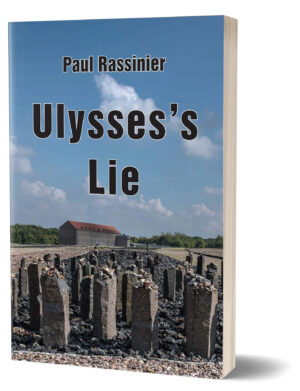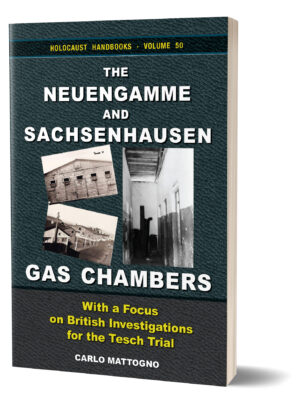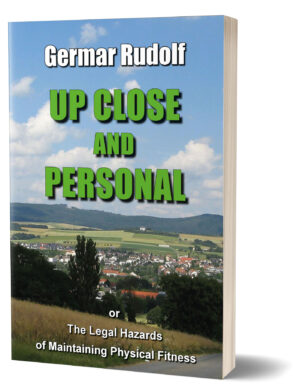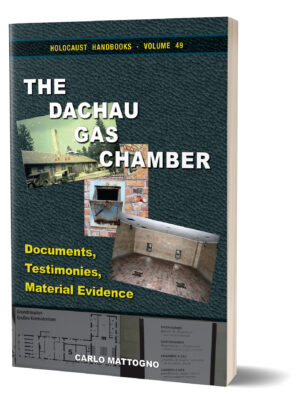Book Announcements
The Dachau Gas Chamber: Documents, Testimonies, Material Evidence
Authored by Carlo Mattogno
Carlo Mattogno, The Dachau Gas Chamber: Documents, Testimonies, Material Evidence, Castle Hill Publishers, Bargoed, November 2022, 6”×9” paperback, 156 pages, index, bibliography, b&w illustrated, ISBN: 978-1-59148-295-6. This is Volume 49 of our prestigious series Holocaust Handbooks. The eBook version is accessible free of charge at www.HolocaustHandbooks.com. The current edition of this book can be obtained as print and eBook from Armreg Ltd, armreg.co.uk/. The book’s first chapter is featured in this issue of Inconvenient History.
We had Carlo’s typescript for this book since September 2021, but got to working on it only in late 2022. There isn’t much documental or testimonial material to base such a book upon, so it is necessarily slender. But since the Dachau “gas chamber” is one of the world’s biggest crowd pleasers when it comes to Nazi horror shows, maybe second only to the Auschwitz equivalent, it is important to address it as best as we can.
Ever since the occupation of the Dachau Camp by the U.S. Army in late April 1945, the homicidal gas chamber claimed to have existed in the camp’s crematorium has been one of the hot spots of Allied atrocity propaganda, and later a mainstay of the orthodox Holocaust narratives. The accusations followed the pattern created by the Soviets after their occupation of the Majdanek and Auschwitz camps in Poland. Both the Soviets and the Americans exaggerated victim numbers and attributed features to these gas chambers which are demonstrably impossible.
While initial witness statements and U.S. reports maintained that poison gas was fed into the chamber through shower heads, the narrative soon changed, and it was alleged that Zyklon B was thrown through openings in the outside wall instead. A third claim states that ampules of an unknown liquid gas were meant to be thrown in through a chute in an inside wall.
This study looks at the available evidence and tries to make sense of it all. Assessing the evidence is very difficult, not only because there are few and contradictory witness and expert reports. There are also problems involving the physical evidence. The equipment alleged to perform these operations makes absolutely no sense if the purpose was indeed to exterminate prisoners.
While SS physician Dr. Siegmund Rascher wrote a letter in 1942 that a facility was being built at Dachau Camp as it existed already in Linz, historians insist that the conversion of a room inside the Dachau Crematorium for the purpose of exterminating human beings only took place in 1944. Rascher’s reference to a facility in Linz points at Hartheim Castle, though victims there are said to have been killed with bottled carbon monoxide, not Zyklon B.
In addition, the heating and ventilation equipment of the Dachau facility was very cumbersome and costly, and yet, it would have been utterly ineffective. Moreover, the currently claimed means of introducing poison gas by simply dumping Zyklon-B pellets irrecoverably on the floor is so primitive that it would have turned any mass gassing into a nightmare for the operators as well. These claims by historians fly in the face of how the Degesch Zyklon-B delousing facilities in the same building were operated. Finally, the room under scrutiny had six massive, fully operable floor drains designed to drain massive amounts of water. But where was that water supposed to come from, if not from real showerheads?
This study attempts to assess these contradictions and show what was realistically possible. It does not deny the injustice of imprisonment and the mistreatment of millions of people during World War Two. However, acknowledging this injustice is possible without exaggerations and the creation of false myths.
* * *
Ulysses’s Lie
Authored by Paul Rassinier
Paul Rassinier, Ulysses’s Lie, Castle Hill Publishers, Bargoed, UK, November 2022, 270 pages, 6”×9” paperback, index, bibliography, ISBN: 978-1-59148-309-0.
Long announced, and long delayed, we finally did it! CODOH’s copy editor Jett Rucker had volunteered years ago to translate it from its original French, but was progressing with it only rather slowly. Hence, earlier this year we retook control of the project, and when we had some free capacity later this year, we wrapped it up and spat it out! It’s the first ever complete translation of Rassinier’s original work, with which Holocaust revisionism took its baby steps. It is also a stark reminder that the National-Socialist world of prison camps was an atrocious world no one wants to relive. After all, you don’t need gas chambers to unleash hell. Ordinary, mean people are all it takes. The current edition of this book can be obtained as print and eBook from Armreg Ltd, armreg.co.uk/. The book’s introduction is featured in this issue of Inconvenient History.
 Paul Rassinier, French socialist and pacifist, was arrested during WWII by the German occupiers of France for trafficking in illegal papers (for Jewish emigrants) and shipped to Buchenwald Concentration Camp in early 1944. After a quarantine stay of several weeks, he was transferred to the forced-labor camp Dora-Mittelbau, where the Third Reich’s infamous retaliatory weapons were assembled by prisoners in tunnels.
Paul Rassinier, French socialist and pacifist, was arrested during WWII by the German occupiers of France for trafficking in illegal papers (for Jewish emigrants) and shipped to Buchenwald Concentration Camp in early 1944. After a quarantine stay of several weeks, he was transferred to the forced-labor camp Dora-Mittelbau, where the Third Reich’s infamous retaliatory weapons were assembled by prisoners in tunnels.
In the first part of this book, Rassinier recounts the horrific detention and labor conditions to which thousands of prisoners were exposed. He reveals how the SS resorted to inmates to run the camp, and that, in return, the inmate leadership resorted to violence and terror to harass their fellow inmates without need.
In the second part, the author analyzes the writings of some personalities who served time with him in the Buchenwald or Dora-Mittelbau Camp: Alfred Untereiner, Jean-Paul Renard, Robert Ploton, Louis Martin-Chauffier, David Rousset and Eugen Kogon. He reveals how these authors were less than scrupulous about telling the truth in order to conceal from the public that in the world of concentration camps it was largely the inmate leadership – to which some of the authors criticized belonged – but not the SS, who were responsible for the terror and mass deaths of their fellow inmates.
This first complete English edition of Rassinier’s first work has been critically annotated in footnotes where necessary and includes for the first time the original introductory prologue, the original preface by Albert Paraz, a number of press reviews that appeared in France, and a brief overview of the criminal proceedings ultimately unsuccessfully brought against Rassinier in France for this book.
It was with this book that Holocaust revisionism began. This classic is important not only because it enlightens us as to how and why many of the survivors spun a web of lies after the war, but it also reminds us that Nazi concentration camps were indeed places of horror, suffering, and crime for long stretches of time, albeit often in different ways than popularly portrayed.
* * *
The Neuengamme and Sachsenhausen Gas Chambers
Authored by Carlo Mattogno
Carlo Mattogno, The Neuengamme and Sachsenhausen Gas Chambers: With a Focus on British Investigations for the Tesch Trial, Castle Hill Publishers, Bargoed, UK, December 2022, 178 pages, 6”×9” paperback, bibliography, ISBN: 978-1-59148-311-3.
Carlo wrapped up that project when we set out to handle his book on Dachau. So, since we were already at it, we killed two books with one approach, translating, editing and publishing them in unison. This is Volume 50 of our prestigious series Holocaust Handbooks, which appeared almost simultaneously both in English and German. The eBook version is accessible free of charge at www.HolocaustHandbooks.com. The current (expanded 2nd) edition of this book can be obtained as print and eBook from Armreg Ltd, armreg.co.uk/.
 A major challenge for critical historical researchers is access to archival materials in European countries that dictate by penal law the results of research into the history of the Third Reich. If a well-known critical historian were to show up in such an archive and ask for access, he would be arrested.
A major challenge for critical historical researchers is access to archival materials in European countries that dictate by penal law the results of research into the history of the Third Reich. If a well-known critical historian were to show up in such an archive and ask for access, he would be arrested.
Thank God, however, that there are a few conscientious established historians who have some backbone and help us critical researchers unofficially and out of sight of law enforcement by providing us with otherwise inaccessible archival material.
In the present case, Carlo Mattogno was given access to archival materials in England and in Germany concerning criminal proceedings conducted by those two countries after the war on alleged events at the Neuengamme and Sachsenhausen Concentration Camps. Of primary interest here are allegations of homicidal gassings in camp buildings converted or misappropriated for this purpose. The evaluation of many interrogation protocols and court testimonies shows that, as the number of statements increases, so do their discrepancies and contradictions.
Particularly illuminating is the way in which British interrogators proceeded in the British Occupation Zone in post-war Germany. Every incriminating statement made by former camp inmates was regarded from the outset as incontrovertible truth. If this “truth” was not confirmed by other witnesses, the interrogators used threats, blatant lies and misleading statements to confuse and trick these recalcitrant witnesses into giving false testimony.
A discussion of the technical absurdities that accompanied the gassing stories about Neuengamme and Sachsenhausen at every turn rounds out this work.
Editor’s Note: The current, 2nd edition of this book includes a reprint of an article by Friedrich Jansson titled “Aspects of the Tesch Trial,” which was first published in Inconvenient History, Vol. 7, No. 1, 2015. Since Carlo Mattogno makes ample reference to this paper in his book, it made sense to include it as the book’s Part 3. Hence, the current edition has 238 pages, and features Friedrich Jansson as co-author.
Miscellaneous Books
Castle Hill released a new edition of the following older book:
 Germar Rudolf, Up Close and Personal: or the Legal Hazards of Maintaining Physical Fitness (October 2022)
Germar Rudolf, Up Close and Personal: or the Legal Hazards of Maintaining Physical Fitness (October 2022)
Germar Rudolf has disappeared! But before he did, he updated and issued this revised edition of his book telling the world about his trials and tribulations in the U.S. as an immigrant who just won’t fit in. Well, Germar wouldn’t be Germar, if he fit in. Read the tale from the horse’s mouth. The eBook version of this book (PDF format) can be purchased at a price that you can set – even zero, if you want to get it free (cheapskate!). The previous edition was titled Moral Turpitude (same subtitle) and featured a “sex sell’s” type of cover artwork that was considered inappropriate, hence has been replaced with a scene of the landscape where Germar grew up (Camberg, Hessen, Germany).
Castle Hill furthermore released the following new German book:
 Carlo Mattogno, The Real Auschwitz Chronicle: The History of the Auschwitz Camps Told by Authentic Wartime Documents (German only for now; December 2022)
Carlo Mattogno, The Real Auschwitz Chronicle: The History of the Auschwitz Camps Told by Authentic Wartime Documents (German only for now; December 2022)
As early as 1998, we came up with the idea to write a chronological history of Auschwitz based solely on impeccable war-time sources. The architect Willy Wallwey, who was in charge of that project initially, unfortunately dropped out in the early 2000s due to age-related issues. But when asked, Carlo was willing to pick up where the project had been dropped, and finish it rather swiftly. We beefed it up with summaries of all the Auschwitz Garrison and Headquarters orders known to mankind, and Carlo added as its second part a thorough analysis of all the deportation transports sent to the camp, of its occupancy throughout the months and years, and of its mortality, which is where the linchpin is, of course. An English translation will take some time, as the book is chock full of quotes in small print from original German wartime documents. This is (or will be) Volume 48 of our prestigious series Holocaust Handbooks. [Editor’s remark 2024: the English edition appeared a few months later; for the print edition, see Armreg Ltd at armreg-co.uk.]
Bibliographic information about this document: Inconvenient History, 2022, Vol. 14, No. 4
Other contributors to this document:
Editor’s comments:

